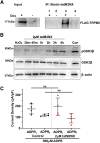Characterization and Optimization of the Novel Transient Receptor Potential Melastatin 2 Antagonist tatM2NX
- PMID: 31772034
- PMCID: PMC6964147
- DOI: 10.1124/mol.119.117549
Characterization and Optimization of the Novel Transient Receptor Potential Melastatin 2 Antagonist tatM2NX
Abstract
Transient receptor potential melastatin 2 (TRPM2) is a calcium-permeable channel activated by adenosine diphosphate ribose metabolites and oxidative stress. TRPM2 contributes to neuronal injury in the brain caused by stroke and cardiac arrest among other diseases including pain, inflammation, and cancer. However, the lack of specific inhibitors hinders the study of TRPM2 in brain pathophysiology. Here, we present the design of a novel TRPM2 antagonist, tatM2NX, which prevents ligand binding and TRPM2 activation. We used mutagenesis of tatM2NX to determine the structure-activity relationship and antagonistic mechanism on TRPM2 using whole-cell patch clamp and Calcium imaging in human embryonic kidney 293 cells with stable human TRPM2 expression. We show that tatM2NX inhibits over 90% of TRPM2 channel currents at concentrations as low as 2 μM. Moreover, tatM2NX is a potent antagonist with an IC50 of 396 nM. Our results from tatM2NX mutagenesis indicate that specific residues within the tatM2NX C terminus are required to confer antagonism on TRPM2. Therefore, the peptide tatM2NX represents a new tool for the study of TRPM2 function in cell biology and enhances our understanding of TRPM2 in disease. SIGNIFICANCE STATEMENT: TatM2NX is a potent TRPM2 channel antagonist with the potential for clinical benefit in neurological diseases. This study characterizes interactions of tatM2NX with TRPM2 and the mechanism of action using structure-activity analysis.
Copyright © 2020 by The American Society for Pharmacology and Experimental Therapeutics.
Figures




Similar articles
-
Ligand-induced activation of human TRPM2 requires the terminal ribose of ADPR and involves Arg1433 and Tyr1349.Biochem J. 2017 Jun 16;474(13):2159-2175. doi: 10.1042/BCJ20170091. Biochem J. 2017. PMID: 28515263 Free PMC article.
-
Selective inhibition of TRPM2 channel by two novel synthesized ADPR analogues.Chem Biol Drug Des. 2018 Feb;91(2):552-566. doi: 10.1111/cbdd.13119. Epub 2017 Nov 15. Chem Biol Drug Des. 2018. PMID: 29034580 Free PMC article.
-
TRPM2 cation channels, oxidative stress and neurological diseases: where are we now?Neurochem Res. 2011 Mar;36(3):355-66. doi: 10.1007/s11064-010-0347-4. Epub 2010 Dec 8. Neurochem Res. 2011. PMID: 21140288 Review.
-
Inhibitory effects of AG490 on H2O2-induced TRPM2-mediated Ca(2+) entry.Eur J Pharmacol. 2014 Nov 5;742:22-30. doi: 10.1016/j.ejphar.2014.08.023. Epub 2014 Aug 30. Eur J Pharmacol. 2014. PMID: 25179574
-
Mechanism of TRPM2 channel gating revealed by cryo-EM.FEBS J. 2019 Sep;286(17):3333-3339. doi: 10.1111/febs.14939. Epub 2019 Jun 10. FEBS J. 2019. PMID: 31144442 Free PMC article. Review.
Cited by
-
Pharmacological Modulation of TRPM2 Channels via PARP Pathway Leads to Neuroprotection in MPTP-induced Parkinson's Disease in Sprague Dawley Rats.Mol Neurobiol. 2022 Mar;59(3):1528-1542. doi: 10.1007/s12035-021-02711-4. Epub 2022 Jan 8. Mol Neurobiol. 2022. PMID: 34997907
-
[Advances in the development of transient receptor potential melastatin 2 channel inhibitors].Zhejiang Da Xue Xue Bao Yi Xue Ban. 2025 Jan 25;54(1):120-130. doi: 10.3724/zdxbyxb-2024-0586. Zhejiang Da Xue Xue Bao Yi Xue Ban. 2025. PMID: 39909465 Free PMC article. Review. Chinese.
-
Role of TRPM2 in brain tumours and potential as a drug target.Acta Pharmacol Sin. 2022 Apr;43(4):759-770. doi: 10.1038/s41401-021-00679-4. Epub 2021 Jun 9. Acta Pharmacol Sin. 2022. PMID: 34108651 Free PMC article. Review.
-
The Antibody Receptor Fc Gamma Receptor IIIb Induces Calcium Entry via Transient Receptor Potential Melastatin 2 in Human Neutrophils.Front Immunol. 2021 May 13;12:657393. doi: 10.3389/fimmu.2021.657393. eCollection 2021. Front Immunol. 2021. PMID: 34054821 Free PMC article.
-
Umbilical cord-derived mesenchymal stem cell conditioned medium reverses neuronal oxidative injury by inhibition of TRPM2 activation and the JNK signaling pathway.Mol Biol Rep. 2022 Aug;49(8):7337-7345. doi: 10.1007/s11033-022-07524-9. Epub 2022 May 18. Mol Biol Rep. 2022. PMID: 35585377 Free PMC article.
References
-
- Alawieyah Syed Mortadza S, Sim JA, Neubrand VE, Jiang LH. (2018) A critical role of TRPM2 channel in Aβ42 -induced microglial activation and generation of tumor necrosis factor-α. Glia 66:562–575. - PubMed
-
- Andoh C, Nishitani N, Hashimoto E, Nagai Y, Takao K, Miyakawa T, Nakagawa T, Mori Y, Nagayasu K, Shirakawa H, et al. (2019) TRPM2 confers susceptibility to social stress but is essential for behavioral flexibility. Brain Res 1704:68–77. - PubMed
-
- Bai JZ, Lipski J. (2010) Differential expression of TRPM2 and TRPV4 channels and their potential role in oxidative stress-induced cell death in organotypic hippocampal culture. Neurotoxicology 31:204–214. - PubMed
Publication types
MeSH terms
Substances
Grants and funding
LinkOut - more resources
Full Text Sources
Medical
Molecular Biology Databases
Research Materials

